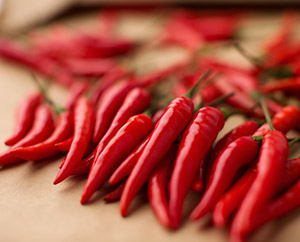- Posted August 31, 2023
test
Capture the Heat and Sweet of Chile Peppers for Flavor and Health

The time for a bumper crop of peppers—hot, mild, and sweet—is coming soon in most parts of the US. Many enjoy the “kick” of a good hot chile pepper, and there may be potential health benefits that accompany that heat. As for sweet and bell pepper varieties, there’s plenty to love, nutritionally speaking, from these peppers as well.
For people with diabetes, peppers offer good nutrition
Bell peppers and other sweet peppers are an excellent source of vitamin C, with one medium green pepper supplying around 90 mg. That’s one and a half times the recommended dietary allowance (RDA) of this important nutrient. Even a small pepper will do the trick by supplying 60 mg of vitamin C, exactly the RDA for men and women. If you have diabetes, getting enough vitamin C is an important goal.
Controlled trials suggest vitamin C may help people keep their blood sugar levels in a healthier range. And in one trial of people newly diagnosed with type 2 diabetes who were being counseled in an effort to improve their health, those who made dietary changes that increased their vitamin C blood levels had a lower risk of cardiovascular disease, compared with people not taking these steps to improve their diet.
Chile peppers also contain a substance called capsaicin, and for people with diabetes, this substance may offer some support for addressing a key goal of diabetes management: maintaining a healthy body weight. Controlled clinical studies suggest that adding chiles to a weight loss diet may improve the amount of weight a person loses above and beyond the diet alone. Another unexpected benefit is that chiles appear to increase satiety—a feeling of fullness after eating. More satiety means less desire to eat again soon after a meal, potentially aiding efforts to maintain a healthier body weight.
Both of these things are important, because according to the American Diabetes Association's Position Statement on Nutrition Therapy Recommendations for the Management of Adults With Diabetes, “For overweight or obese adults with type 2 diabetes, reducing energy intake while maintaining a healthful eating pattern is recommended to promote weight loss.” The recommendation to reduce energy intake receives an A grade, indicating the highest level of evidence supports it.
Adding in the sweet and taking the heat
Green, red, orange, and yellow bell peppers provide delicious flavor and festive color to any salad. These vegetables also dress up kabobs; try stacking chunks of colorful bell peppers between chicken or other items on your skewers. Also, try sliced bell peppers dipped in hummus for a quick and easy snack.
If you’re new to adding chile peppers to your diet, ease into it gradually; start with the varieties that aren’t quite so hot. If you are unfamiliar with a particular pepper, ask about the spiciness before buying and start with a very small amount to make sure you’re comfortable with that level of heat.
When you’re cooking with chiles, remember: DON’T TOUCH your face or eyes until you’ve washed your hands. The residue from the chiles on your hands could cause a burning sensation.
Try placing fresh chiles right on the grill; the chile skin will blister and peel, and you can cook them to your preferred level of doneness. More cooking usually means a little less spiciness, though not always, so proceed with caution. For fish or chicken, try a spicy mango, jalapeño, and basil relish. Simply chop and combine ingredients, and serve as a colorful and flavorful garnish with your main entrée.
(Diabetes Care. 2013;36(11):3821-42.)
Copyright © 2023 TraceGains, Inc. All rights reserved.










